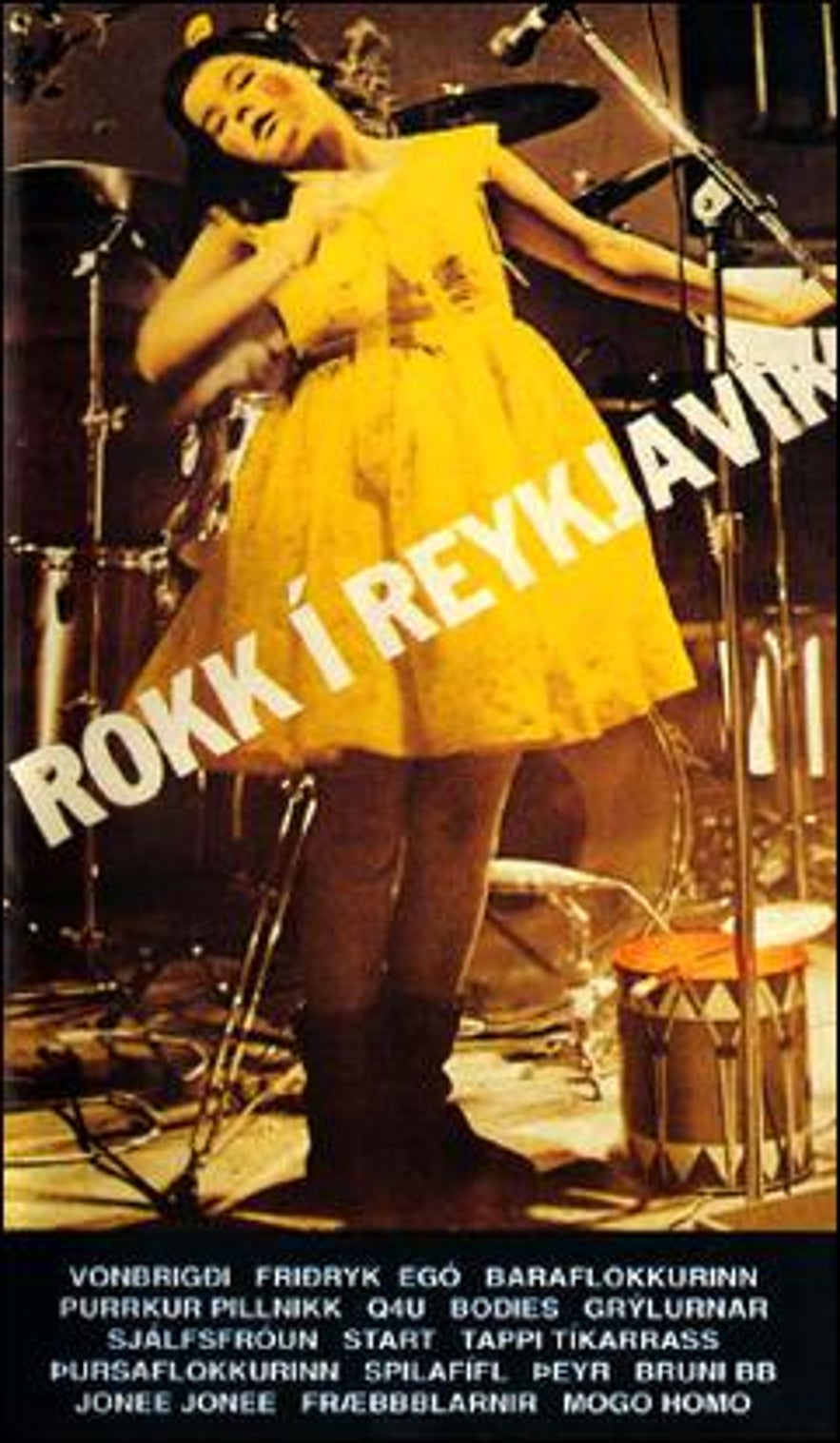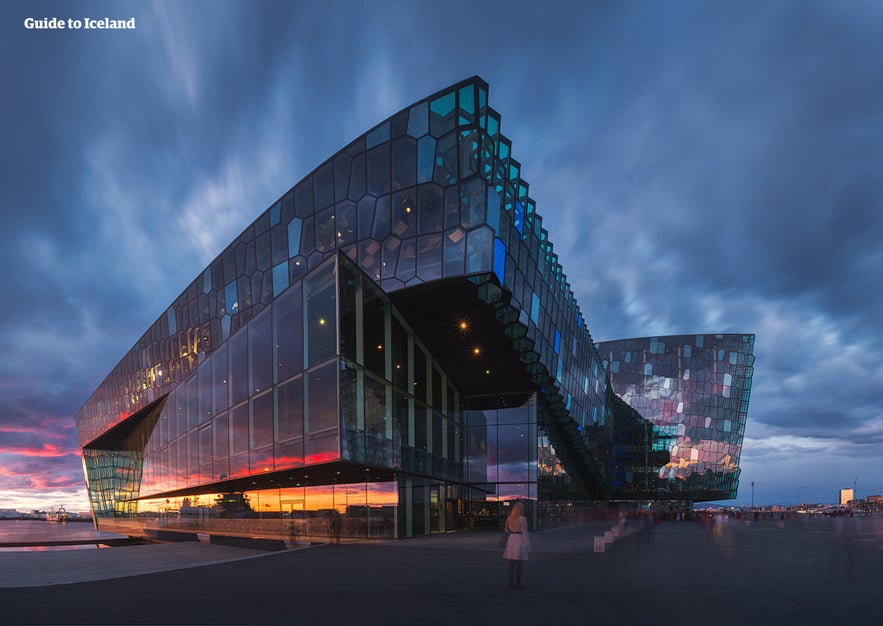After your visit to Iceland, an album of Icelandic music makes for a meaningful souvenir. Or if you’re planning a visit, listening to Icelandic music is a perfect way to prepare.
- See the sights of Reykjavík with this Hop On - Hop Off City Sightseeing Tour
- Soak up the brews of Iceland with a Reykjavík City Beer Tour
- Taste the city with the Reykjavik Food Walk
- Discover local watering holes in the Reykjavík Bar Crawl
- Unique luxury in the North - enjoy the Beer Spa from Akureyri
But in this age of algorithm-made playlists catered to listeners’ specific tastes, isn’t it more special to enjoy records as a whole work of art?
Why You Can Trust Our Content
Guide to Iceland is the most trusted travel platform in Iceland, helping millions of visitors each year. All our content is written and reviewed by local experts who are deeply familiar with Iceland. You can count on us for accurate, up-to-date, and trustworthy travel advice.
 Photo from Wikimedia, Creative Commons, by Laganart. No edits made.
Photo from Wikimedia, Creative Commons, by Laganart. No edits made.
Icelanders always want to be the best at everything, at least per capita, using our small population as a strength. In the past hundred years or so, there’s been an emphasis on access to music instruction for Icelandic children. Having highly-skilled musicians has become an important part of the cultural landscape.
Icelandic music is now a product for export, with bands like Sigur Rós, Kaleo and Of Monsters and Men at the forefront. At the same time, festivals like Iceland Airwaves and Secret Solstice bring music lovers from around the world to our little island.
If you’re the kind of person who prefers listening to a complete album by one artist or band, here are some recommendations for Icelandic albums. The list is in no way exhaustive.
Litill Fugl– Elly Vilhjalms
Elly Vilhjálms is without a doubt Iceland’s most beloved chanteuse. Many of the songs she recorded have been radio standards since they first came out.
Her popularity is such that in March 2017, Reykjavík City Theatre premiered a jukebox musical based on the singer’s life. The musical is still running, as of this article’s publication in January 2019.
The album chosen for this list – Lítill Fugl (A Little Bird) – was released in 1994 and contains twenty of the singer’s most popular songs. Elly’s oeuvre forms a cohesive whole on this best-off type album.
Elly only released two solo albums, a Christmas themed one and an album of Icelandic versions of songs from films and musicals. On the latter the singer herself chose popular songs to sing.
Some of these songs feature on Lítill Fugl, sung in Icelandic with Elly’s soothing voice giving them an irresistibly homely quality. Among them are “Hverskonar bjálfi er ég”, a near-direct translation of the musical show-stopper turned jazz standard “What Kind of Fool am I”.
The album doesn’t consist entirely of covers of foreign songs. Among the Icelandic songs is a favourite of many Icelanders “Ég veit þú kemur”. The song was written by legendary song writing duo from the Westman Islands; Oddgeir Kristjánsson and Ási í Bæ.
Many say the lyrics to “Ég veit þú kemur” (English: I know you’ll come) are about the songwriters' friendship but Elly herself said she preferred singing it with the intention of a romantic love song. Her version is the definitive one according to most Icelanders.
Lítill Fugl ends with the ethereal “Sveitin milli sanda”. The song has no lyrics, Elly sings the melody on a beautiful open vowel sound. This song is the perfect endpoint to the nostalgic journey that this album inspires.
I recommend listening to Lítill Fugl while doing tasks in the kitchen. Relax and let Iceland’s favourite crooner take your imagination back to a simpler time.
Mavastellid – Grylurnar
 Photo from Wikimedia, Creative Commons, by Rokk í Reykjavík. No edits made.
Photo from Wikimedia, Creative Commons, by Rokk í Reykjavík. No edits made.
Punk arrived a bit late in Iceland. In most other countries punk and new wave peaked in the late seventies but here the early eighties were the height of punk rock in Iceland.
The 1982 documentary Rokk í Reykjavík by director Friðrik Þór Friðriksson allows a unique insight into the vibrant punk and new wave scene in Reykjavík in the winter of 1981-82. One of the bands featured in the film is the all-female punk group Grýlurnar.
Frontwoman Ragnhildur Gísladóttir auditioned the other girls for the band and some of them couldn’t even play their assigned instruments when they started rehearsing, in true punk rock fashion. This didn’t stop the band from providing catchy tunes with engaging lyrics. The rough-around-the-edges feel of some of the songs just makes them more charming.
Mávastellið is Grýlurnar’s only full length album. Some of the songs on Mávastellið can also be found on the album Með Allt á Hreinu which was released along with a film of the same title.
In the film, Grýlurnar play a fictionalized version of the band named Gærurnar. The film revolves around a band that splits into two when the two lead singers break up. The other band in the film, Stuðmenn, is among the most prolific and longstanding bands in Iceland. After Grýlurnar disbanded, Ragnhildur joined Stuðmenn permanently.
Grýlurnar’s use of gibberish, mixing of languages and nonsensical lyrics can be seen as a feminist statement. This deconstruction of language being a rejection of the patriarchal system of semiotics. “Sísí” for example has lyrics in both French and Icelandic as well as babbling and repetition of the nick-name Sísí, which makes the song’s lyrics harder to understand.
An alternate version of the song appeared in Með Allt á Hreinu where the lyrics are about how the all-female band have had enough of the men’s antics. In that version they repeatedly call the men idiots, ball sacks and foot odours. Turning the song from a possible feminist anthem to a full-on man hating chant.
A favourite of mine on the album is the bouncy cover of Bob Dylan’s “Don’t Think Twice It’s All Right”. Grýlurnar’s cutesy performance of the song serves to add irony to the already sarcastic lyrics.
This album is the kind best enjoyed in your childhood bedroom, where you can sing along like the angsty teenager you still are on the inside.
Gling-Glo – Bjork
Björk may be best known for the experimental sounds of albums like the Grammy nominated Homogenic, Medúlla, and Biophilia but a favourite of many Icelandic Björk fans is a lesser known jazz album. Her 1990 collaboration with Tríó Guðmundar Ingólfssonar, Gling-Gló.
At the time Björk was best known for being a member of The Sugarcubes. Previously she had released a solo album when she was only twelve-years-old and been the lead singer of new wave group Tappi Tíkarrass, which was featured in the aforementioned Rokk í Reykjavík documentary.
- See also: The Björk Saga
On Gling-gló the sounds of fairly traditional jazz blend beautifully with Björk’s unique vocal performances and the outcome is easy-listening jazz which is full of flavour. The trio – Guðmundur Ingólfsson, Guðmundur Steingrímsson and Þórður Högnason – play piano, drums and double bass, respectively. The songs on the album are covers of jazz-standards which, except for the last two, have lyrics in Icelandic.
The album’s onomatopoeic title – Gling-Gló – is taken from the first song on the album and the name refers to the chiming of a clock. The playfulness of the instrumentation and vocals in that song are present throughout the album, notably in songs like “Bella Símamær”.
The lyrics of that song are about a woman who spends all her time on the phone and the song starts with the piano and drums building into a sound which is reminiscent of the ringing of a telephone.
This album is in my humble opinion the best thing to have on in the background when you have guests over. It creates a pleasant backdrop if you choose not to listen to it and it’s fun to listen, dance and even sing along to if the mood takes you, and it’s by Björk so you’ll seem cool.
Guerilla Disco– Quarashi
Quarashi raps in English, which is indicative of their status as one of the earliest rap groups in Iceland. Nowadays most Icelandic rappers choose to spit rhymes in their mother tongue.
- See also: Hip Hop in Iceland
Guerilla Disco is considered closer to gangster-rap than Quarashi’s previous, more rock rock-rap inspired work. However, the samples used keep a light-hearted feel to the album, especially the use of the Oompa Loompa song from Willy Wonka & The Chocolate Factory on “Dead Man Walking”.
With three rappers splitting MC duties and the varied use of samples there’s no risk of getting bored with this album. There are also tracks without rapping – “Audio Amigos” and “Steua” – which give the listeners a break from the word flow and time to admire Sölvi Blöndal’s skill as a producer.
Another quality which makes the album light-hearted is how obviously the gangster-rapper persona is an act for them. As you can hear on “Stun Gun” when Tiny (already, not a typical name for a gangster-rapper) states “I like my weekends private / Real peaceful and quite / Don’t condone violence / read books for recreation”.
In the video for “Stun Gun” the band can be seen competing with another foursome at shooting clay pigeons, which is about as close to a shootout as Icelandic rappers get.
The band has been mostly inactive since shortly after this album came out, aside from a reunion concert in 2009 and the release of the song “Chicago” in 2016. We’ll keep our fingers crossed for a comeback so the people of Iceland can once more pull our pants up and put our hands up at a Quarashi concert.
Until then, Guerilla Disco is great to listen to while driving late at night, just be careful to keep an eye on the speedometer as it will inevitably get you hyped up.
Hjalmar– Hjalmar
Hjálmar’s self-titled second album is sometimes nick-named Lopapeysuplatan (English: The Wool-jumper record) because the cover art features a close up of a traditional Icelandic knitted jumper. Hjálmar play reggae infused with Icelandic folk influences, which is exactly as chill as that sounds.
When this album was released there were a number of Swedish musicians in the band in addition to some of Iceland’s best musicians, making it a Scandi-reggae feast for the ears. Hjálmar were the first popular reggae band in Iceland, but certainly not the last.
- See also: Icelandic Reggae… Really?
The band’s singers Sigurður Guðmundsson and Þorsteinn Einarsson each have distinct vocal qualities which work together to add to the overall soothing atmosphere of the album. Sigurður’s voice is at its best on “Til þín” and Þorstein’s on “Geislinn í vatninu”.
The whole album runs through smoothly like the musical equivalent of a cup of chamomile tea, each song like a warm sip, more beautiful and relaxing than the last. This album should be a regular on everyone’s Sunday morning album rotation.
Timarnir Okkar– Sprengjuhollin
If you put Sprengjuhöllin on it’ll send anyone who was a teenager in Reykjavík in 2008 directly to their nostalgia fuelled wits end. The five piece band shot to the top of the Icelandic music scene fast, burned bright for a short time and split up.
Following the success of their debut album, Tímarnir Okkar, they made a second album the following year, Bestu Kveðjur, which didn’t fare as well as their first. A seemingly deliberate move to join the ranks of bands afflicted with second album syndrome. Especially considering the album’s title is a common send-off at the end of letters, similar to Best Wishes or Kind Regards.
Conspiracy theories aside, Sprengjuhöllin left us with their so-so second album and one perfect album, Tímarnir Okkar.
Each song on the album feels like an anthropological study of a different aspect of Icelandic nationality. The titular “Tímarnir okkar” (English: Our Times) is the clearest example of this.
In it Bergur Ebbi, one of the bands two lead singers, rambles on almost incoherently. It’s as if we’re hearing half of a drunken conversation happening in down-town Reykjavík on a Saturday evening spoken/sung over a catchy song.
The lyrics aren’t fully contextualized in any way but somehow it’s a conversation we’ve all had with a first year Philosophy student at The University of Iceland at a house-party somewhere in Laugardalur.
In addition to most of the songs being catchy as all hell, there are some unforgettable vocal performances on the album. Bergur Ebbi has a real knack for memorable phrasing. But the real singing talent of the group is Snorri Helgason.
Since the tragic end of Sprengjuhöllin Snorri has become one of Iceland’s most beloved folk-musicians and his solo albums are all well worth a listen. On this album his voice gets room to shine on songs like “Verum í sambandi” and “Flogin er finka”.
The album is a road-trip essential. The first song “Keyrum yfir Ísland” (English: Let’s drive across Iceland) is even about a road trip and includes the lyric “You can come with, but we don’t want any losers”. So if you’re not a loser, join Sprengjuhöllin on their trip around Iceland, right now. Seriously, get in your car, put Tímarnir Okkar on and start driving.
Skalmold og Sinfoniuhljomsveit Islands– Skalmold & Iceland Symphony Orchestra

Iceland prides itself in its musicians and classical musicians are no exception. The Icelandic Symphonic Orchestra has since 1950 delighted Icelanders with world class classical music performances.
As well as playing more traditional orchestral pieces The Symphonic Orchestra has collaborated with many popular artist on more unconventional performances. On this live concert album they join forces with one of Iceland’s best known metal bands, Skálmöld.
Skálmöld’s first album Baldur was a surprise hit since they had been rejected by all the Icelandic labels they approached. Baldur was eventually released by a record company in the Faroe Islands. Some of the songs from that album are on this concert album along with songs from the band’s second album Börn Loka.
Skálmöld combine metal with the sounds of traditional Icelandic music. Their albums are concept albums which tell folk stories or explore Norse Mythology.
In addition to the six member metal band and full symphonic orchestra the album also features guest singers and no less than 3 choirs. A men’s choir, a chamber choir and a children’s choir. As they say, if it’s worth doing, it’s worth over doing.
Skálmöld’s music is already always played at full throttle but the orchestral arrangements make their music even more epic. The only correct way to enjoy this album is to invent a time-machine and attend the concert.
Island Broadcast- FM Belfast
FM Belfast is an electro-pop group of varying size. They have 3 to 8 members and are known for bringing their all to live performances. During last year's Iceland Airwaves a member of the band crowd surfed out of the venue, around a car and back on stage during their concert.
Island Broadcast is the band’s fourth studio album and their best since debut album How to Make Friends. Island Broadcast is decked with wall to wall bangers, including “All My Power”, the only song off the album which has a music video. And what a music video!
FM Belfast’s sound is infectiously energetic. That’s why their live shows are such a success. There is no way to listen to their music and sit still, you’ve gotta move!
What makes the songs on this album better than other catchy electronic pop are the lyrics. Sometimes nonsensical, often sadder than the music indicates, always earworms.
An excellent example of their brilliance is “You’re so Pretty”. An insanely catchy, happy-sounding song with depressing lyrics, a wonderful juxtaposition. Shaking your booty while singing “I don’t know if I should drown myself” along with Lóa Hlín is therapeutic.
Listen to this album when you need to dance. Not when you simply want to dance but when every bone in your body needs to dance.













